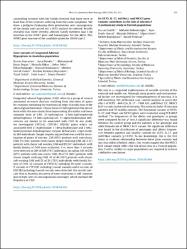| dc.contributor.author | Özdilli, Kürşat | |
| dc.contributor.author | Bekerecioğlu, Mehmet | |
| dc.contributor.author | Nursal, Ayşe Feyda | |
| dc.contributor.author | Pehlivan, Mustafa | |
| dc.contributor.author | Sever, Ülgen | |
| dc.contributor.author | Büyükgüral, Berker | |
| dc.contributor.author | Pehlivan, Sacide | |
| dc.date.accessioned | 10.07.201910:49:13 | |
| dc.date.accessioned | 2019-07-10T19:50:19Z | |
| dc.date.available | 10.07.201910:49:13 | |
| dc.date.available | 2019-07-10T19:50:19Z | |
| dc.date.issued | 2018 | en_US |
| dc.identifier.citation | Özdilli, K., Bekerecioğlu, M., Nursal, A., Pehlivan, M., Sever, Ü., Büyükgüral, B. ... Pehlivan, S. (2018). Do UCP2, IL-17, mi196a2, and NR3C1 gene variants contribute to the risk of microtia? A preliminary study in Turkish population. European Biotechnology Congress içinde (S21-S21. ss.). Athens, Greece, April 26-28, 2018. https://dx.doi.org/10.1016/j.jbiotec.2018.06.064 | en_US |
| dc.identifier.issn | 0168-1656 | |
| dc.identifier.issn | 1873-4863 | |
| dc.identifier.uri | https://dx.doi.org/10.1016/j.jbiotec.2018.06.064 | |
| dc.identifier.uri | https://hdl.handle.net/20.500.12511/1948 | |
| dc.description | European Biotechnology Congress -- APR 26-28, 2018 -- Athens, GREECE | en_US |
| dc.description | WOS: 000454825900062 | en_US |
| dc.description.abstract | Microtia is a congenital malformation of variable severity of theexternal and middle ear. Although many genetic and environmen-tal factors are investigated the etiopathogenesis of microtia, it isstill uncertain. We performed case–control analysis to assess theeffect of UCP2−866 G/A, IL-17−7488 A/G, miR196a2 T/C, NR3C1Bcl1 variants on the risk of microtia. This study includes 18 microtiapatients and 70 healthy controls. The functional variants of UCP2,IL-17, miR196a2, andNR3C1genes were evaluated using PCR-RFLPmethod. The frequencies of the alleles and genotypes in groupswere compared by the 2test A significant difference was foundbetween the control group and the patients as for genotype andallele frequencies of NR3C1 Bcl1 variant. No significant differencewas found in the distribution of genotypes and alleles frequen-cies between patients and healthy controls for UCP2, IL-17, andmiR196a2 variants (p> 0.05). To our knowledge, this is the firststudy to evaluate relationship between these gene variants andmicrotia risk in a Turkish cohort. Our results suggest that theNR3C1Bcl1 variant might reflect the risk of microtia in a Turkish popula-tion. Further studies in larger populations are required to achievea definitive conclusion. | en_US |
| dc.language.iso | eng | en_US |
| dc.publisher | Elsevier Science Bv | en_US |
| dc.rights | info:eu-repo/semantics/openAccess | en_US |
| dc.title | Do UCP2, IL-17, mi196a2, and NR3C1 gene variants contribute to the risk of microtia? A preliminary study in Turkish population | en_US |
| dc.type | conferenceObject | en_US |
| dc.relation.ispartof | European Biotechnology Congress | en_US |
| dc.department | İstanbul Medipol Üniversitesi, Tıp Fakültesi, Dahili Tıp Bilimleri Bölümü, Çocuk Sağlığı ve Hastalıkları Ana Bilim Dalı | en_US |
| dc.authorid | 0000-0002-7129-5024 | en_US |
| dc.identifier.volume | 280 | en_US |
| dc.identifier.issue | Supplement: S | en_US |
| dc.identifier.startpage | S21 | en_US |
| dc.identifier.endpage | S21 | en_US |
| dc.relation.publicationcategory | Konferans Öğesi - Uluslararası - Kurum Öğretim Elemanı | en_US |
| dc.identifier.doi | 10.1016/j.jbiotec.2018.06.064 | en_US |
| dc.identifier.wosquality | Q2 | en_US |


















